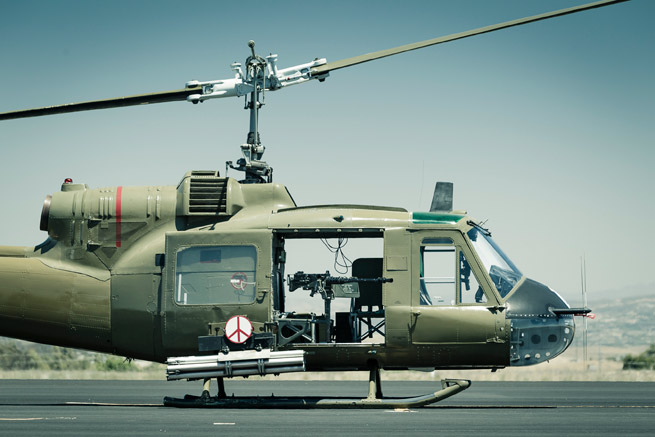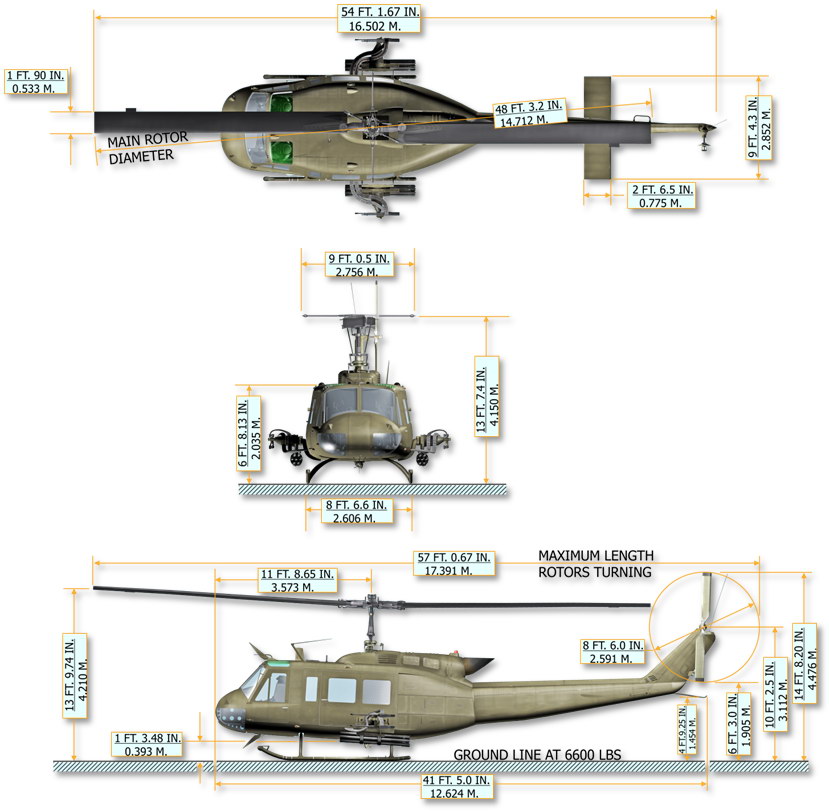While driving south on US-41 crossing the border from Wisconsin to Illinois, there sits Russell Military Museum which, as they say, is where history comes alive. With over 300 exhibits at this military museum that include tanks, jeeps, fixed-wing aircraft, helicopters, watercraft, engines, rifles, and cannons. The exhibits time eras range from Civil War era to World War 2 era and all the way to modern currently in-use vehicles. One of their featured exhibits is the line of multiple Bell UH-1 Iroquois, more famously known as the “Huey”. The Huey is the symbol of the Vietnam War for many and was an important piece in American aviation history.

Design and Operation of the “Huey”
The reason this helicopter excelled in its role is primarily due to the design of it. It was manufactured by a company called Bell Helicopter. [4] Bell Helicopter built 10,005 Hueys from 1957 to 1975 and over 7000 of them served in the Vietnam War, which is over half of the 11,800 helicopters that saw action. Of those 7000, 3305 of the were destroyed during combat. [5]
It has an 1100 horsepower gas turbo-shaft engine that was able to perform at higher temperatures and in less-dense air than other helicopters. This allows the engine to work in at higher elevation and in almost any weather. The Huey’s engine was also much lighter than previous helicopter engines which allowed it to be smaller (48-foot rotor diameter, 57 foot length), lighter, and more maneuverable. The rotor was a underslung rotor system that has counterbalances to the two blades. An underslung rotor system allows the rotor to tilt which keeps the center of mass of the blade the same distance away from the mast. This allows the rotor to not be affected by the Coriolis Effect and lead to less forces being put on the blades or rotor hubs. Because of this system, it was a very easy ride compared to most other helicopters. Chief Warrant Officer Dwayne Stanislaw says piloting a Huey was like driving a Cadillac and was a smooth ride. [1] Another side effect to this rotor system was that once the blades got up to speed, a popping sound could be heard. This is a common sound with most helicopter because the blades are turning fast enough that they break the sound barrier. But with the Huey, the popping sound is much slower because there are only two blades compared to the traditional four blades. In an interview with Navy Aviation Ordinanceman Craig Williams, he states that once you hear a Huey flying, you will never be able to forget the sound of it. [2]
With these advantages, it was much faster with a max cruising speed of a 130 miles per hour, a ceiling of over 18,000 feet (which is almost three and half miles) and a climb rate just under 1800 feet per minute. The Huey had a range of 315 miles on one tank. This usually lead to about 5 hours of flight time on one tank of fuel. It had the ability to carry up to 16 passengers and crew or carry just under 4000 pounds of equipment in the cabin or 5000 pounds in an external sling. [6]

When approaching a combat zone, a Huey would need to hover a few feet above the ground so the soldiers could leap off. Having wide doors so troops could get in and out quickly was an important design aspect of the Huey. This also allowed the Hueys to lift out of the combat zone in short order to minimize risk of being shot down. [7] The Huey could also be modified into a gunship for close air support (CAS). It could be equipped to fire fourteen 70mm rockets, M60 machine guns, or M134 minigun from each side by the doors as well as a 40mm automatic grenade launcher turret in the chin position. [8] According to Ernest Furgurson, crewmen wearing body armor manned machine guns at each door, secured by what they called a “monkey strap” as the craft angled and tilted. [7] The Army later took this ability to be a gunship for CAS and created a new helicopter strictly made as a gunship. This was the Huey Cobra, which had the same engine, rotor, and gearbox as the original Huey.
The Huey is piloted by an Aircraft Commander and a Co-pilot. The other two crewmembers were the Crew Chief and a Door Gunner. In many units, the Aircraft Commander and Crew Chief were assigned a specific aircraft and Co-pilots generally rotated among unit aircraft. The Crew Chief and Door Gunner were responsible for helicopter maintenance where as the Aircraft Commander was in command of the helicopter at all times with the Co-pilot assisting Aircraft Commander when needed. [9]
Role of the “Huey”
The Huey was the main helicopter that was used during the Vietnam War and future upgrades led it to be one of the main helicopters used in Desert Storm era as well. This helicopter became a go-to because of its utility and its toughness. During the Vietnam War, it served as an air ambulance or medical evacuation, armed patrol and escort, command and control, combat reconnaissance support as well as a troop transport and cargo transport. MEDEVAC helicopters flew nearly 500,000 missions and airlifted over 900,000 patients. [4,6] The US Army Hueys totalled more than 7.5 million flight hours in the Vietnam War between October 1966 and the end of 1975, which is believed to be the most combat flight time than any other aircraft in the history of US warfare. [5] According to Millett and Maslowski, the “Huey” helicopters gave the US Army and Marine Corps air mobility that added effectiveness in the war with the North Vietnamese Army. [10]
There are many stories throughout the Vietnam War that display key role the Huey. One story was told to me by Navy Aviation Ordnanceman Craig Williams. His friend Jeff was a Marine gunnery sergeant working on a recon mission. They were in two man teams and as they were completing the mission, they came upon enemy North Vietnamese fire and were pinned down. They had called in for air support to come pick them up. Three helicopters were sent in. two Air Force Skyraiders, also known as Douglas A-1, came to lay down cover fire and take out the enemy. The other helicopter was a Huey. The Marine sergeant knew that a Huey was on the way because he knew the sound and he wanted to cry because he knew that he was going to be rescued. After they got into the helicopter and climbing into the air, an enemy fired a rocket-propelled grenade (RPG) and because of the maneuverability of the Huey; it missed the nose by 10-15 feet. [2]
There are other stories throughout the Vietnam War that show how tough the Huey was throughout the campaign. One story by Chief Warrant Officer Dave Gehling is a good example. CWO Gehling was flying his Huey gunship through notorious Zone D and his chopper had been shot up by crossfire from machine guns by attacking enemy forces. In addition to the injuries to his leg, bullets cut his transmission and half of his power in the helicopter. [7] Because the toughness of the Huey, CWO Gehling was able to make it back to base, get healed up, and go back for more.
During Desert Storm era, the Huey served many of the same roles. Other roles it served as described by Chief Warrant Officer Duane Stanislaw, who was an Army helicopter pilot during Desert Storm, were for VIP transports, high-ranking officials transport, and what is known is “ash-n-trash”. [1] This is the pilot’s language for doing a bunch of utility work around the base.
An example of how the Huey played an important role during Desert Storm is shown in an interview with Corporal Morris Strain of the Marine Corps. He and his company were deployed to Saudi to an ammo supply base for security. He was the sergeant of security and would send his men in a Humvee to do the six perimeter checks. During a round of perimeter checks, they men missed checkpoint four so another Humvee was sent to see what had happened and found the first one flipped over on its roof. The driver was seriously hurt and broke his neck. A Huey was called to MEDEVAC the driver over 100 miles to the closest medical site that could handle an injury such as that one. [3]
Role Outside of War

Today, many Hueys are used as monuments for the men that flew them during the Vietnam War. There are some that are used in order to help Vietnam veterans that suffer from post-traumatic stress disorder (PTSD). One example of this is called “Take Me Home Huey”. The purpose of this art piece is to get veterans to talk about their experiences in order to help them heal. The Huey is a great tool for this because to all Vietnam veterans, the Huey is a symbol of help and safety since the Huey was the one that was always bringing them home.
After over 40 years of service, the Marine Corps retired the last UH-1N Huey helicopter 28 August 2014 at NAS Joint Reserve Base in New Orleans and the Army’s last Huey mission was 15 December 2016. [11] There are still many serviceable Hueys that exist today. Many of them are used by State Forestry Departments for fighting wildfires. Others are used today by many different police and law enforcement departments. The Air Force still uses the Hueys for missile base security, search and rescue, and to shuttle government officials and visiting heads of state around Washington DC. [12] The Symbol of the Unpopular War has served, been upgraded, and now is being replaced by newer models of helicopters such as the Apaches and Blackhawks.
Primary Sources
- Stanislaw, Duane. 13 Nov. 2017. Phone Interview
- Williams, Craig. 13 Nov. 2017. Phone Interview
- Strain, Morris. 4 Nov. 2017. In-person Interview
Secondary Sources
- “Bell UH-1B/C Huey Cobra/Frog Gunship Helicopter.” (2016) Military Factory.
- “Helicopter Losses During the Vietnam War.” Vietnam Helicopter Pilots Association.
- “Bell UH-1V “Huey“.”(2008) Delaware Valley Historical Aircraft Association.
- Furgurson, Ernest B. (2015) “The Huey Defined America’s Presence in Vietnam, Even to the Bitter End.” Smithsonian.com
- Hutchison, Harold C. (2017) “Why the Huey Became a Symbol of Vietnam War.” Warrior
- “UH-1H Iroquois “Huey” Helicopter.” (2015) Vietnam Helicopters Museum
- Millett, Allan Reed, et al. For the common defense a military history of the United States from 1607 to 2012. Free Press, 2012.
- Phillips, Josh. (2014) Naval Aviation News; Washington Vol. 96, Iss. 4, : 36-37.
- Jones, Jeffrey Frank. The UH-1 Iroquois/Huey Helicopter in Stories, Photographs and Film. 2012.
For Further Reading
- https://takemehomehuey.org
- https://en.wikipedia.org/wiki/Bell_UH-1_Iroquois
